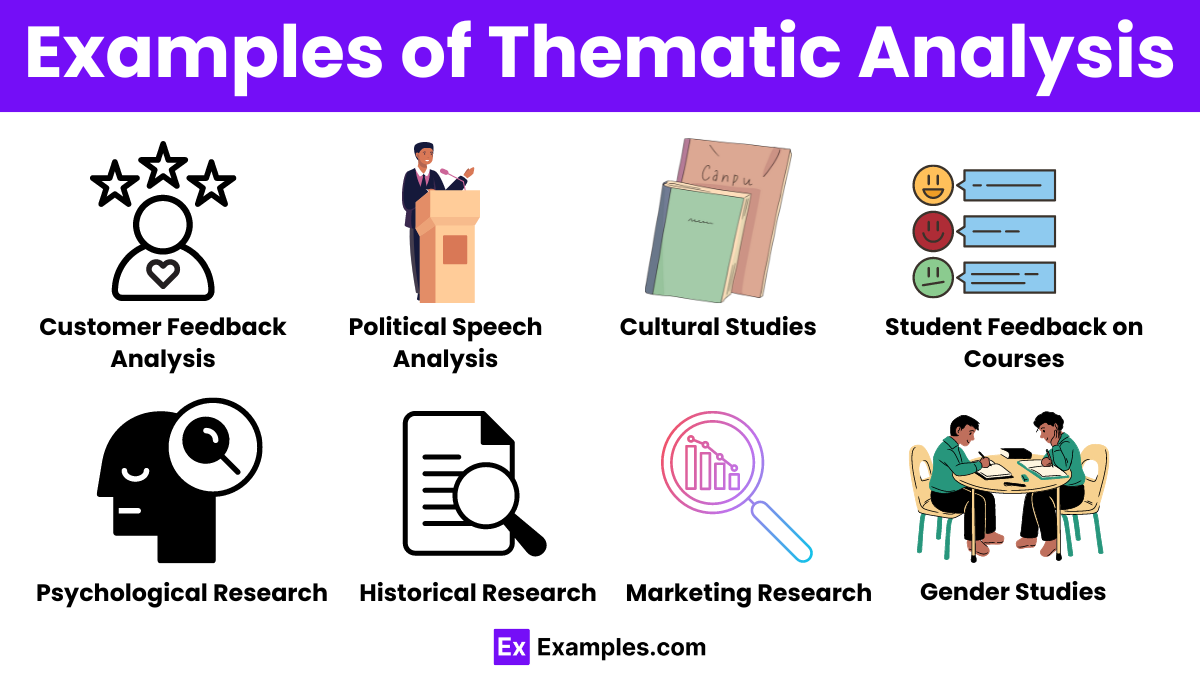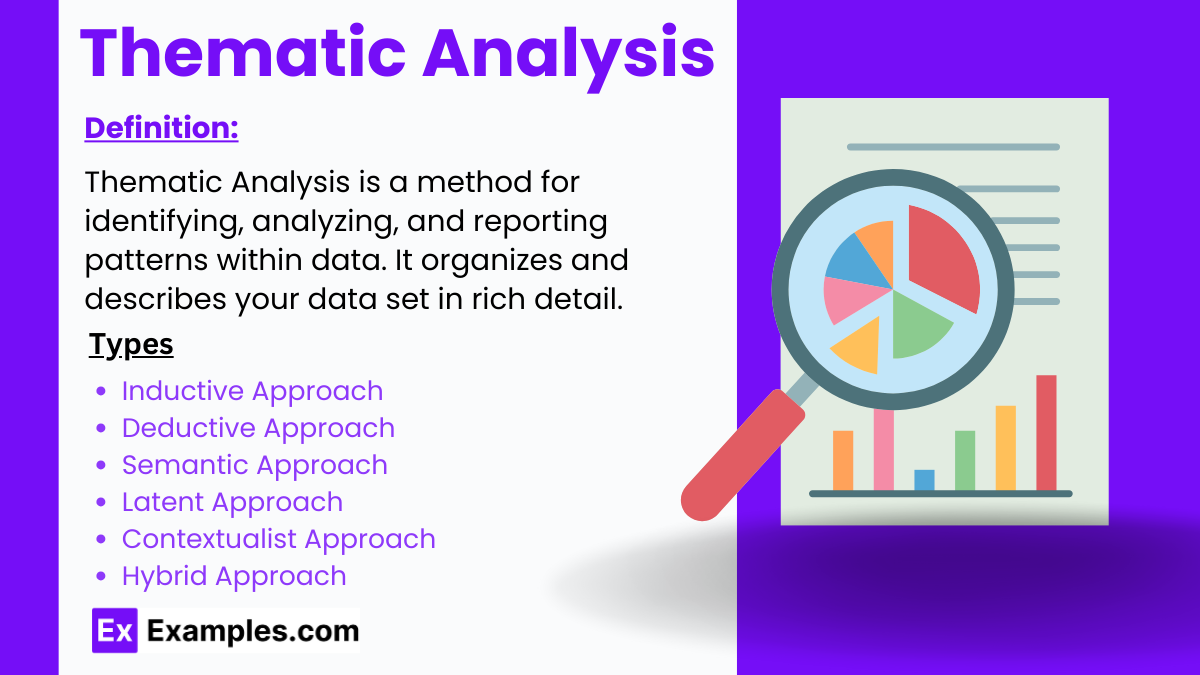30+ Thematic Analysis Examples to Download
Thematic Analysis is a method for identifying, analyzing, and reporting patterns (themes) within data. It minimally organizes and describes your data set in rich detail. A thematic statement captures the main ideas and insights derived from the data, providing a clear narrative for the study. Significance of the Study Qualitative Research lies in its flexibility and ability to uncover complex phenomena from detailed textual data. Qualitative data, including interviews, focus groups, and open-ended survey responses, are ideal for Thematic Analysis as they provide in-depth insights into participants’ perspectives and experiences.
What is Thematic Analysis?
Thematic Analysis is a qualitative research method for identifying, analyzing, and reporting patterns or themes within data. It organizes and interprets various aspects of the research topic to reveal meaningful insights.
Examples of Thematic Analysis

- Customer Feedback Analysis: Identifying common themes in customer reviews to improve service.
- Employee Satisfaction Surveys: Analyzing responses to understand workplace morale.
- Patient Experience in Healthcare: Extracting themes from patient interviews to enhance care quality.
- Student Feedback on Courses: Summarizing themes from course evaluations to improve teaching methods.
- Media Content Analysis: Identifying themes in news articles to understand media bias.
- Literature Review: Categorizing themes in academic papers on a specific topic.
- Social Media Trends: Analyzing hashtags and posts to identify popular trends and sentiments.
- Community Needs Assessment: Gathering themes from focus group discussions to address community issues.
- Marketing Research: Identifying themes in consumer preferences to develop new products.
- Political Speech Analysis: Extracting themes from political speeches to understand campaign strategies.
- Cultural Studies: Analyzing themes in cultural texts to understand societal values.
- Educational Research: Identifying themes in teacher interviews to improve educational practices.
- Environmental Studies: Analyzing themes in public opinion on environmental issues.
- Psychological Research: Identifying themes in therapy session transcripts to understand patient issues.
- Workplace Diversity Studies: Extracting themes from employee interviews to improve inclusion policies.
- Gender Studies: Analyzing themes in narratives to understand gender roles and experiences.
- Urban Planning: Identifying themes in community feedback on city development projects.
- Historical Research: Extracting themes from historical documents to understand past events.
- Consumer Behavior Studies: Analyzing shopping habits to identify purchasing themes.
- Public Health Research: Identifying themes in health behavior studies to design better interventions.
When should you Use Thematic Analysis?
Exploratory Research: When you need to explore unknown aspects of a phenomenon or gather insights without a predetermined hypothesis.
Qualitative Data: When your research involves qualitative data such as interviews, focus groups, open-ended survey responses, or textual content.
Complex or Multifaceted Data: When you aim to understand and interpret complex, detailed, or multifaceted data to identify underlying patterns and themes.
Comparative Analysis: When you want to compare themes across different groups or contexts to understand variations and commonalities.
Theory Development: When you are aiming to develop new theories or refine existing ones based on in-depth qualitative insights.
Rich Descriptions: When your goal is to provide a rich, detailed description of a particular phenomenon, experience, or process.
Policy and Practice Insights: When you seek to derive practical recommendations or policy implications from qualitative data.
Participant Perspectives: When understanding participants’ perspectives, experiences, and meanings is central to your research objectives.
Types of Thematic Analysis
Inductive Approach
- Data-Driven: Themes are identified from the data without a pre-existing framework or theory.
- Bottom-Up: Themes emerge from the raw data through coding and analysis.
- Flexibility: Allows for the discovery of unexpected insights.
Deductive Approach
- Theory-Driven: Themes are identified based on existing theories or prior research.
- Top-Down: Uses a predetermined coding framework to guide the analysis.
- Focused: Ensures the analysis addresses specific research questions or hypotheses.
Semantic Approach
- Explicit Meanings: Focuses on the explicit content and surface meanings of the data.
- Descriptive: Describes what participants have said without inferring deeper meanings.
- Clarity: Provides clear and straightforward themes that are easily understood.
Latent Approach
- Underlying Ideas: Looks beyond explicit content to identify underlying ideas, assumptions, and conceptualizations.
- Interpretive: Requires interpretation to uncover deeper meanings and insights.
- Depth: Provides a deeper understanding of the data by exploring the root causes and implications of the themes.
Contextualist Approach
- Context-Sensitive: Considers the context in which the data was collected and the influence of the researcher.
- Balanced: Balances between participants’ subjective experiences and the broader social context.
- Reflexive: Emphasizes the importance of reflexivity and the researcher’s influence on the analysis.
Hybrid Approach
- Combination: Integrates elements of both inductive and deductive approaches.
- Flexible: Allows for the use of a theoretical framework while remaining open to new themes emerging from the data.
- Comprehensive: Provides a thorough analysis by combining the strengths of different approaches.
How to do Thematic Analysis
1. Familiarization with the Data
Description: This initial step involves getting to know your data deeply. It includes transcribing a data, reading through the text multiple times, and taking initial notes.
Steps:
- Transcribe data: If you have a recordings, transcribe them verbatim.
- Read and re-read: Go through the text several times to become deeply familiar with the content.
- Initial notes: Jot down initial impressions and ideas.
2. Generating Initial Codes
Description: Coding involves organizing your data into meaningful groups. This process helps to summarize and condense the data into key points.
Steps:
- Identify interesting features: Highlight significant pieces of data that seem relevant to your research question.
- Label segments: Assign codes to different parts of the text. Codes are concise phrases or words that capture the essence of the segment.
- Collate data: Group all data extracts that are related to each code.
3. Searching for Themes
Description: In this step, you begin to identify broader patterns of meaning (themes) within your coded data.
Steps:
- Review codes: Examine your codes and look for patterns or overarching themes.
- Organize codes: Group similar codes together into potential themes.
- Create themes: Develop themes that capture the main ideas and narratives present in your data.
4. Reviewing Themes
Description: This stage involves refining your themes to ensure they accurately represent the data.
Steps:
- Check against data: Ensure that each theme accurately reflects the coded data and the overall dataset.
- Refine themes: Modify, combine, or discard themes as necessary.
- Create a thematic map: Visualize the relationship between themes and sub-themes to get a clearer picture.
5. Defining and Naming Themes
Description: At this point, you clearly define what each theme is about and give them concise, descriptive names.
Steps:
- Detailed analysis: Write a detailed analysis for each theme, specifying what it captures and how it relates to the research question.
- Theme names: Assign clear, descriptive names to each theme that encapsulate their essence.
6. Producing the Report
Description: The final step involves writing up your thematic analysis. This should provide a coherent and persuasive account of your data, highlighting the key themes and supporting them with evidence.
Steps:
- Introduction: Outline your research question, the importance of the study, and the methodology.
- Theme descriptions: Present each theme with detailed explanations and illustrative quotes from the data.
- Discussion: Relate your findings to the broader context, existing literature, and theoretical frameworks.
- Conclusion: Summarize the key findings and their implications.
Qualitative Research of Thematic Analysis
1. Data Collection
Collect qualitative data through various methods such as interviews, focus groups, observations, or document analysis.
Methods:
- Interviews: Conduct semi-structured or unstructured interviews to gather detailed, personal accounts.
- Focus Groups: Facilitate group discussions to explore collective perspectives.
- Observations: Record behaviors and interactions in natural settings.
- Document Analysis: Analyze texts, reports, and media to extract relevant information.
2. Data Familiarization
Immerse yourself in the data by reading and re-reading it to become deeply familiar with its content and context.
Activities:
- Transcription: Transcribe a recordings verbatim.
- Reading: Go through the transcripts and notes multiple times.
- Initial Notes: Jot down initial thoughts and impressions.
3. Initial Coding
Break down the data into meaningful units by assigning codes to different segments.
Activities:
- Highlighting: Identify and highlight significant pieces of data.
- Coding: Label segments with concise codes that capture their essence.
- Collating: Group all data extracts related to each code.
4. Theme Development
Identify patterns among the codes to develop broader themes that represent the data’s main ideas.
Activities:
- Review Codes: Examine the codes to find commonalities.
- Group Codes: Organize similar codes into potential themes.
- Create Themes: Formulate themes that encapsulate the core ideas.
5. Theme Review
Refine the themes to ensure they accurately reflect the data and provide a coherent narrative.
Activities:
- Validation: Compare themes against the original data to verify accuracy.
- Refinement: Modify, combine, or discard themes as necessary.
- Thematic Map: Visualize the relationships between themes and sub-themes.
6. Theme Definition and Naming
Clearly define and name each theme to convey its essence and relevance.
Activities:
- Detailed Analysis: Write comprehensive descriptions for each theme.
- Naming: Assign descriptive names that succinctly capture the themes’ meanings.
7. Reporting
Write up the findings in a coherent and persuasive report that presents the themes and supports them with data extracts.
Activities:
- Introduction: Outline the research question, importance, and methodology.
- Theme Presentation: Describe each theme in detail, supported by quotes from the data.
- Discussion: Relate findings to existing literature and theoretical frameworks.
- Conclusion: Summarize key insights and discuss implications.
Tips & Suggestions
- Stay Close to the Data: Ensure themes accurately represent participants’ perspectives.
- Be Flexible: Adapt your approach as new insights emerge.
- Maintain Rigor: Keep a detailed audit trail to ensure transparency and credibility.
- Use Software Tools: Consider using qualitative data analysis software like NVivo or ATLAS.ti.
- Reflect on Biases: Continuously reflect on and address your biases throughout the analysis process.
What is thematic analysis?
Thematic analysis identifies and interprets patterns (themes) within qualitative data.
Why use thematic analysis?
It offers flexibility and provides rich, detailed, and complex data interpretation.
How do you start thematic analysis?
Begin with data familiarization through thorough reading and note-taking.
What is coding in thematic analysis?
Coding involves labeling significant data segments to identify patterns.
What are themes in thematic analysis?
Themes are broader patterns or ideas that emerge from coded data.
How are themes validated?
Themes are validated by comparing them against the original data.
What software aids thematic analysis?
Tools like NVivo and ATLAS.ti help organize and analyze qualitative data.
Can thematic analysis be both inductive and deductive?
Yes, themes can emerge from data (inductive) or pre-existing theories (deductive).
How to ensure thematic analysis reliability?
Maintain a detailed audit trail and regularly review data consistency.
What is a thematic map?
A visual representation showing the relationships between identified themes.


